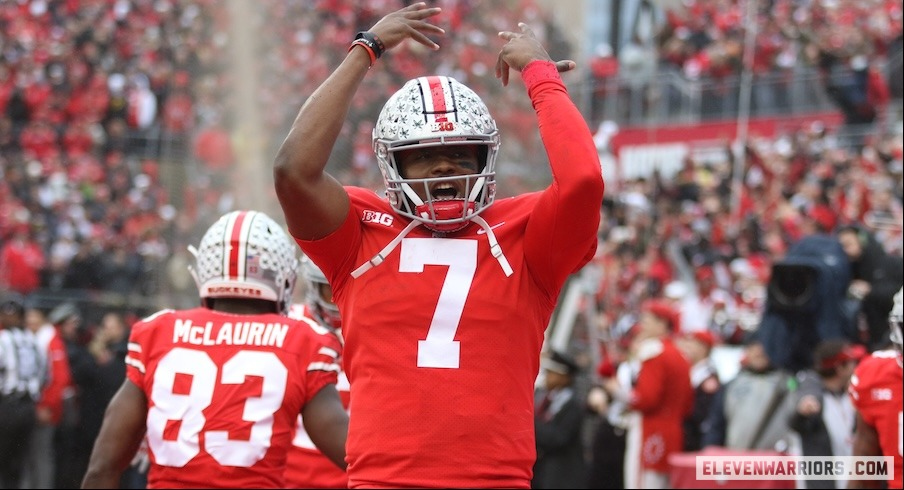Part 3 of Ohio State’s Top 25 Games of the Quarter-Century features two unforgettable national championship victories, a pair of explosive, record-smashing offensive performances, and a momentum-shifting triumph over archrival Michigan that helped redefine an era.
Ohio State football has built a tradition steeped in dominance, pride, and unforgettable moments, but there’s something uniquely special about the collection of games that make up Part 3 of the Buckeyes’ Top 25 Games of the Quarter-Century. This portion of the list delivers not just pivotal victories but foundational ones—games that define legacies, set records, and altered the trajectory of the program’s national reputation. It’s the kind of stretch that Buckeye fans don’t just remember—they relive it, argue about it, cherish it, and pass it on like family heirlooms.
At the center of this section are two national championship wins. These aren’t just any titles; they are towering achievements that encapsulate years of grit, resilience, and the unmistakable swagger that Ohio State football brings to the field. The first, the iconic double-overtime classic against the Miami Hurricanes in the 2003 Fiesta Bowl, still stirs debate and admiration. It wasn’t just a game—it was a clash of dynasties. Ohio State entered the matchup as a considerable underdog against a Miami team considered among the greatest of all time, featuring an NFL-caliber lineup that had steamrolled its way through the season. What happened next was nothing short of epic. The Buckeyes, led by a ferocious defense, clutch plays from Craig Krenzel, and a defining fourth-and-14 conversion, pulled off one of the most thrilling upsets in college football history. The controversial pass interference call in overtime still sparks heated conversation, but what’s undeniable is the toughness and resilience the Buckeyes displayed on that stage. It wasn’t just a win—it was a coronation, a statement that Ohio State was back on top of the college football world.
Fast forward over a decade, and the Buckeyes found themselves in another national championship, this time in the inaugural College Football Playoff in 2015. The opponent: the Oregon Ducks, led by Heisman Trophy winner Marcus Mariota. But for all the hype around Oregon’s high-octane offense, the Buckeyes brought with them a storybook run and an identity forged in adversity. Behind a third-string quarterback in Cardale Jones, and with Ezekiel Elliott exploding onto the national scene with an unforgettable performance, Ohio State once again claimed the title. The 42-20 victory wasn’t just another feather in the cap—it was a full-blown exclamation point. The Buckeyes imposed their will, with a physicality that drowned out the speed and finesse of the Ducks. That game was more than a championship—it was a cultural reset, a demonstration of depth, coaching, and a team peaking at the perfect moment. Elliott’s 85-yard touchdown run in the fourth quarter is etched into Buckeye lore, a symbol of dominance that no one saw coming a month earlier.
While championship games naturally steal the spotlight, Part 3 also highlights two offensive showcases that redefined what Ohio State football could look like in terms of explosiveness. One such performance came during a demolition of Wisconsin, where the Buckeyes’ offense was nothing short of electric. It wasn’t just the final score that impressed—it was the manner in which they overwhelmed a traditionally stout Badgers defense. Every drive seemed to end with fireworks, and the Buckeyes displayed a level of efficiency and flair that signaled a new era. Whether it was pinpoint passing, punishing runs, or strategic ingenuity, the offense delivered one of those rare games where it felt like every play was a highlight. It was a symphony of speed and power, the kind of outing that causes opponents to stare blankly at the scoreboard and fans to lose their voices before halftime.
The other offensive explosion featured a high-scoring affair where Ohio State simply could not be stopped. It was a showcase of precision and pace, the kind of game where you knew early that something historic was unfolding. Whether it was racking up 600+ yards or setting a new school or conference record, the Buckeyes left no doubt about their offensive ceiling. The quarterback play was near flawless, the wide receivers were slicing through coverage, and the running game looked like a sledgehammer with wheels. It was a masterclass in play-calling and execution, and the kind of game that opponents dread and fans remember forever. What stood out most wasn’t just the numbers—it was how easy they made it look, a pure display of firepower that made the rest of the college football world take notice.
But no series of games defining the Buckeyes’ greatness would be complete without mentioning the one that always means more—The Game. In this case, it was a tide-turning win over Michigan that helped shift the balance of power in the most storied rivalry in sports. Every matchup with Michigan carries significance, but this one carried the weight of recent struggles and looming questions. Could Ohio State reassert itself against the Wolverines after some bruising setbacks? Would the Buckeyes bend to the pressure, or rise with urgency and focus? The answer came in a performance that blended grit, strategy, and explosiveness. The win not only calmed any nerves among the fanbase but reminded the entire nation that Ohio State still owned the edge in the rivalry. There was a tone to that win—a defiance that reignited belief and swagger. It wasn’t just about beating Michigan—it was about sending a message that Ohio State wasn’t going anywhere.
What makes this batch of games so remarkable is how layered each of them is. They’re not just thrilling on the surface—they’re laced with drama, pressure, legacy implications, and iconic moments. Whether it’s a championship win, an offensive masterstroke, or a rivalry triumph, each game reflects different aspects of the program’s identity. You see the physical toughness in the Miami win, the strategic excellence in the Oregon title, the offensive innovation in the blowouts, and the emotional intensity in the Michigan battle. Together, they tell a story not just of success, but of evolution.
There’s also something to be said for how these games shaped perception beyond Columbus. Nationally, Ohio State’s ability to win in different styles against different kinds of teams cemented its place among the sport’s true elites. Whether it was outmuscling SEC teams, outscoring Pac-12 powers, or outlasting Big Ten rivals, the Buckeyes showed a completeness that few programs could match. These games didn’t just contribute to win totals—they built a case for Ohio State as a program with staying power, with standards that outlast coaching changes, roster turnover, and shifting landscapes in college football.
Behind all of this, of course, were the players and coaches who turned gameplans into reality. From the legendary names like Maurice Clarett, Troy Smith, and Ezekiel Elliott, to the unsung heroes who made crucial tackles, blocks, or reads at pivotal moments, these games became legendary because of their execution. The coaches—whether it was Jim Tressel, Urban Meyer, or the assistants pulling strings from the sidelines—crafted moments where preparation met opportunity, and the team rose to meet the moment again and again.
Perhaps the greatest testament to these games is how vividly they live on in the memories of those who witnessed them. Fans can recall exactly where they were when the flag flew in overtime against Miami. They remember the stunned silence turning into roaring celebration when Elliott broke free against Oregon. They’ve watched replays of JT Barrett sneaking for first downs, Cardale Jones launching bombs, and Braxton Miller spinning defenders out of their cleats. These aren’t just games—they’re chapters in Ohio State’s living history.
Part 3 of this countdown doesn’t just feature games—it showcases milestones. These are the kind of games that get replayed on fall Saturdays when there’s a lull in the action, the ones featured in documentaries and remembered in speeches during spring practices. They’re reference points, teaching moments, and recruiting tools. They inspire current players and set the bar impossibly high for future ones. They also unite generations of fans, giving grandparents and grandchildren alike a shared language rooted in victory.
So as fans look back on Part 3 of Ohio State’s Top 25 Games of the Quarter-Century, they’re not just remembering wins—they’re revisiting masterpieces. These are the games that reminded the college football world why Ohio State is not only one of the most successful programs in history but one of its most iconic. And if history is any indication, more such moments are always waiting just around the corner.



